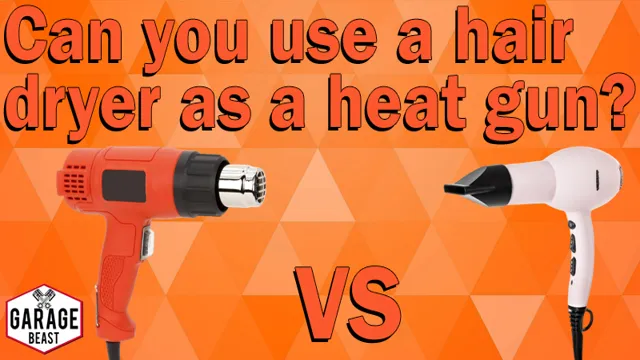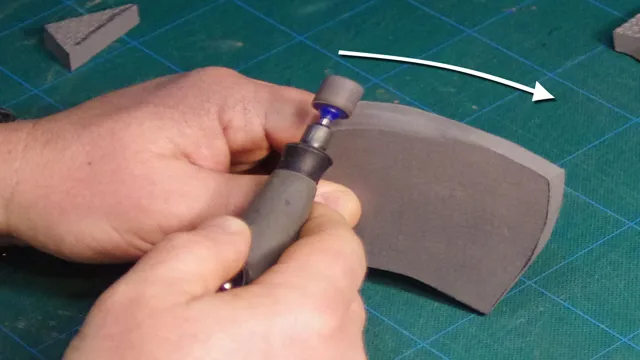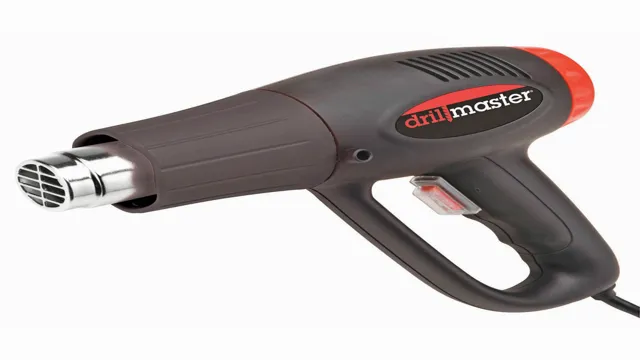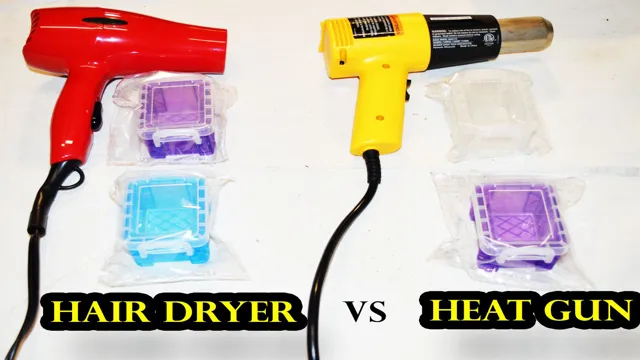How to Use a Heat Gun Safely and Effectively: Complete Guide
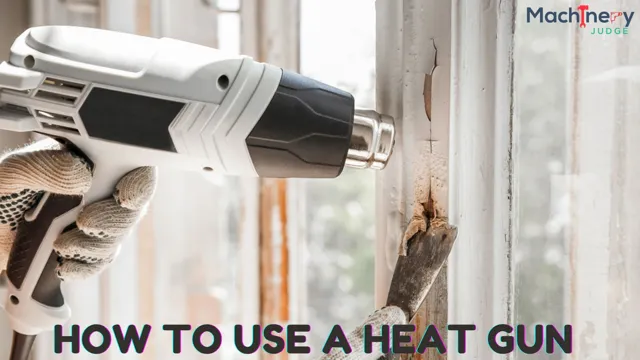
Have you ever found yourself in the midst of a project that requires a heat gun, and realized you have no idea how to use one? Fear not, for you are not alone. Heat guns can seem intimidating to beginners, but with a little bit of guidance, they can become a valuable tool in your DIY arsenal. In this beginner’s guide, we’ll cover the basics of how to use a heat gun, from choosing the right heat setting, to safety tips and practical applications.
Think of a heat gun as a hair dryer on steroids – capable of applying intense heat to a variety of surfaces, making it a versatile tool for a number of projects. Whether you’re looking to strip paint, shrink wrap, or even create DIY crafts, a heat gun is a useful tool to have at your disposal. So, grab your safety glasses and let’s dive into how to use a heat gun like a pro.
What is a Heat Gun?
A heat gun is a versatile tool that emits hot air through a nozzle to achieve a variety of tasks. It is commonly used for removing paint, drying wood, softening adhesives, and thawing frozen pipes. Heat guns work by converting electrical energy into heat energy to produce hot air, which is emitted through the nozzle.
When using a heat gun, it is important to keep the nozzle at a safe distance from the surface and to avoid overheating any one area to prevent damage. Heat guns come in various sizes and power levels, so it is best to choose the one that is suitable for the task at hand. With proper usage, a heat gun can be a valuable tool for any DIY enthusiast or professional.
So, now that you know what a heat gun is, let’s dive into how to use a heat gun for your next project.
Definition
A heat gun is a powerful tool used for heating and drying materials. It is a type of handheld device that can produce hot air ranging from 100 to 1300 degrees Fahrenheit, depending upon the model. Heat guns are commonly used by professionals in various industries, including construction, automotive, crafting, and DIY projects.
They are often used to remove paint, bend plastic, shrink wrap, and soften adhesives. In essence, a heat gun is like a hair dryer, but with higher power and temperature. Its primary function is to supply a targeted flow of hot air precisely where it is needed, making it a versatile and indispensable tool for many applications.
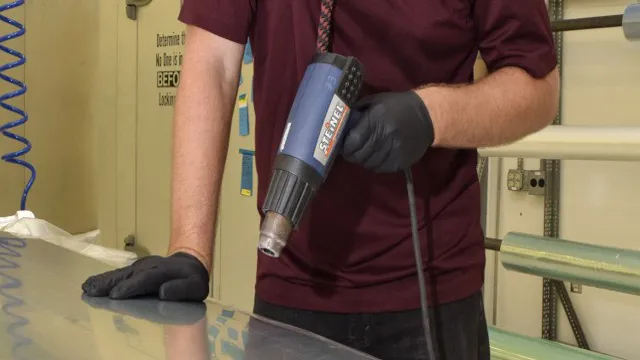
Types of Heat Guns
A heat gun is a versatile tool that generates hot air and is used for various purposes such as shrinking plastic, bending PVC, and drying paint. The heat gun has two types: industrial and household. Industrial heat guns have higher temperature ranges and are used for heavy-duty jobs, while household heat guns are designed for smaller household projects.
Additionally, there are corded and cordless heat guns. Cordless heat guns are portable and can be used in places without electrical sockets. It is important to consider the job you need to complete and the type of heat gun you need before making a purchase.
By choosing the right heat gun, you can ensure that your work is done efficiently and effectively.
Safety Precautions
Using a heat gun can be incredibly useful for a variety of tasks, but it’s important to take proper safety precautions to avoid injury. Firstly, always wear protective eyewear to prevent any hot debris from getting into your eyes. Secondly, ensure that your work area is well-ventilated, as heat guns can produce fumes that can be harmful if inhaled.
It’s also a good idea to wear gloves to protect your hands from burns. When using the heat gun, be sure to keep it moving constantly and never point it at anything flammable. Additionally, keep the gun at a safe distance from your body and never touch the nozzle while it’s still hot.
Lastly, always allow the heat gun to cool down completely before putting it away or storing it. By following these simple safety precautions, you can use a heat gun safely and effectively without any accidents or injuries.
Protective Gear
Protective gear is an essential part of any activity or job that involves potential hazards. It not only protects you from any injuries but also reduces the severity of the damage you may sustain. When it comes to safety precautions, protective gear is the first defense you have against accidents.
For instance, helmets, gloves, goggles, safety vests, and steel-toed boots offer protection against potential head injuries, cuts, burns, chemical burns, and sprains. Moreover, wearing protective gear is not only necessary, but it should also be mandatory. Safety is not something to be taken lightly, and investing in the right protective gear is essential.
You may be asking yourself, “what is the harm in taking shortcuts and not wearing protective gear?” But think about it. Would you drive your car without a seatbelt? Would you ride a bike without a helmet? Of course not! So why risk your life and well-being by not wearing protective gear? Remember, it is not just about your personal safety, it is also about being safe for the people around you. So, the next time you lace up your boots or pick up your tools, don’t forget to put on your protective gear.
Your safety is in your hands.
Proper Ventilation
Proper ventilation is a significant aspect of ensuring safety in any building. Adequate ventilation helps to maintain good indoor air quality by removing pollutants, moisture, and unpleasant odors. It also helps to prevent the buildup of harmful gases such as carbon monoxide that can cause serious health problems.
It is essential to ensure that all rooms in a building have proper ventilation, particularly in spaces where there is a lot of moisture, such as bathrooms and kitchens. Adequate ventilation can be achieved by installing good quality exhaust fans that can extract stale air and bring in fresh air. Additionally, it is essential to ensure that ventilation systems are regularly maintained and cleaned to prevent the buildup of dust and debris, which can compromise their efficiency.
By ensuring proper ventilation, you can be sure that the air you breathe is clean and safe, and that your building is a healthy and safe place to be.
Avoid Flammable Materials
When it comes to safety precautions, one of the most important things to consider is avoiding flammable materials. Flammable materials, such as gasoline, solvents, and propane can easily catch fire and lead to dangerous situations. It’s important to store these materials in a safe and secure location away from any potential ignition sources.
Additionally, it’s important to properly dispose of any flammable materials to avoid any accidental fires. Another important safety precaution is to ensure that your home or workplace has functional smoke detectors and fire extinguishers. By taking these steps, you can help keep yourself and those around you safe from potential fire hazards.
So the next time you’re handling flammable materials, remember to take the necessary safety precautions to avoid any accidents or injuries.
Using a Heat Gun
If you’re wondering how to use a heat gun, it’s not as complicated as you might think! First things first, make sure you have all the necessary safety gear, such as gloves and eye protection. Once you’re equipped, you can start by plugging in the heat gun and setting the temperature to the desired level. Point the nozzle at the surface you want to heat, keeping it at a distance of at least a few inches.
Be sure to keep the heat gun moving constantly to avoid scorching or damaging the surface. You can use a heat gun for a variety of tasks, such as softening adhesive or removing paint. Just remember to always handle it with care, as the high temperatures can cause serious injury if not used properly.
With a little practice, you’ll be a heat gun pro in no time!
Step 1: Prepare Your Workspace
Before you start using a heat gun, it’s important to prepare your workspace properly. Find a space that has good ventilation to avoid inhaling fumes, and clear the area of any potentially flammable materials. Remember to put on safety gear such as gloves and goggles to protect yourself from burns and flying debris.
Once you’re set up, turn on the heat gun and let it warm up for a few minutes before using it on your desired surface. This will help to prevent any sudden bursts of heat that might cause damage to your project. With a bit of preparation, using a heat gun is a safe and effective way to tackle a wide range of DIY tasks around your home or workshop.
Step 2: Aim the Heat Gun
When using a heat gun, it’s crucial to aim it correctly to achieve the desired results. Before starting, make sure you have your protective gear on to avoid any accidents. Hold the heat gun at a comfortable distance from the surface you’re working on, which typically should be 2-4 inches away.
Point the nozzle at the area that needs the most heat, such as a stubborn adhesive or paint. Move the heat gun back and forth slowly to distribute the heat evenly across the surface. Don’t hover or stay in one spot too long, or you’ll risk burning or scorching the area.
Keep the heat gun moving until you reach the desired outcome. By following these instructions and aiming your heat gun correctly, you can successfully accomplish your project.
Step 3: Start Heating the Object
If you’re looking to heat up an object quickly and efficiently, a heat gun is an excellent tool to have on hand. These versatile devices use high heat to warm up a wide variety of materials, from plastic and metal to wood and paint. To start using a heat gun, first, ensure that you have the appropriate safety gear, including eye protection and heat-resistant gloves.
Next, aim the nozzle of the heat gun at the object you wish to heat up and apply heat gradually, moving the gun back and forth over the surface. As the object warms up, you may begin to notice changes in its texture or color. Be careful not to overheat the object, as this can lead to damage or deformation.
Keep a safe distance from the object and avoid pointing the heat gun at any flammable materials nearby. With a little practice, you’ll be able to use your heat gun to quickly and efficiently heat a wide variety of materials.
Step 4: Adjust Temperature and Airflow
One of the crucial steps in using a heat gun is to adjust the temperature and airflow. The heat gun’s temperature can be adjusted depending on the task at hand, whether you need to apply mild heat or high heat intensity. It’s important to use the correct temperature to avoid damaging the material you’re working on.
The airflow, on the other hand, is adjusted to control the amount of heat that is produced by the heat gun. A high airflow setting produces a lot of heat, while a low airflow setting produces less heat. You can also adjust the distance between the heat gun and the material to control the intensity of the heat.
It’s worth noting that different materials require different temperature settings, so it’s essential to research the right temperature and airflow setting for the material you’re working on. By doing so, you can ensure that you’re using the heat gun correctly and getting the best results. In summary, adjusting the temperature and airflow on a heat gun is a critical step to ensure successful results.
Both settings can be controlled, depending on the task at hand, and adjusting them correctly can prevent damage to the material. Researching the correct temperature and airflow settings for the material you’re working on is essential to achieve optimal results. Remember, always use the right setting to ensure you have a great experience.
Step 5: Use Accessories, if needed
Using a heat gun as an accessory is an excellent way to add some flair to your crafts. Not only does it allow you to shape and mold certain materials, but it can also be used to add some texture and dimension. Heat guns are especially helpful when working with materials like embossing powder, shrink wrap, and foam.
Using a heat gun for these tasks will help the material to set in place, react or solidify under some heat. But remember, always exercise caution when using a heat gun. When in use, think of it as a mini flamethrower.
Don’t heat the material for more than a few seconds at a time, and always keep a safe distance from the material so as not to burn it or yourself. With proper care and caution, a heat gun can be an incredibly useful tool in your crafting arsenal.
Common Uses of a Heat Gun
If you’re wondering how to use a heat gun, there are plenty of common applications for this versatile tool. One of the most popular uses is for crafting and DIY projects. A heat gun can help you shape and mold materials like plastic, rubber, and clay.
You can also use it to dry and set paint or glue quickly. In home improvement, heat guns are handy for stripping paint, thawing frozen pipes, and removing stubborn adhesive or stickers. In automotive work, they can help remove dents and wrinkles from vinyl upholstery or dashboard covers.
When working with electronics, a heat gun can be used to shrink tubing over wire connections or to de-solder circuit boards. With a bit of practice, you can find all sorts of uses for a heat gun in your hobbies and projects.
Removing Paint
Heat Gun If you’re looking for an effective way to remove paint from surfaces, a heat gun might just be your new best friend. Applying heat to old layers of paint can soften the bonds that hold them in place, making it easier to scrape or peel them off. It can be especially helpful for tricky spots like corners or intricate woodwork designs where sandpaper can’t reach.
But removing paint is just one of many common uses for a heat gun. They can also help with tasks like thawing frozen pipes, bending plastic, and even lighting a charcoal grill. While heat guns can be useful, it’s important to handle them with care to avoid damaging surfaces or causing injury.
Always wear protective gear and read the manufacturer’s instructions carefully before use. So whether you’re a DIY enthusiast or a professional contractor, a heat gun is a versatile tool that can make many tasks easier and faster.
Shrinking Shrink Wrap
A heat gun can be used for a variety of tasks, but one of its most common uses is for shrinking shrink wrap. This product is often used in packaging to protect and secure products during transit. Heat guns are used to shrink the shrink wrap, making it tighter around the product and providing extra protection to prevent damage.
Other common uses for a heat gun include removing paint, thawing frozen pipes, and bending plastic. You can even use a heat gun for arts and crafts projects, such as embossing or drying paint. A heat gun is a versatile tool that can be used in many different situations, making it a must-have for any DIY enthusiast or professional.
So, whether you’re looking to shrink wrap your products or tackle any other task, a heat gun is definitely worth considering. So, if you want to make sure your packages arrive safely or remove that stubborn paint, grab a heat gun today, and get the job done quickly and efficiently.
Thawing Frozen Pipes
Thawing Frozen Pipes During winter, it’s not uncommon for pipes to freeze, causing water to stop flowing. This can be frustrating and even dangerous. However, using a heat gun can help defrost the pipes and get the water flowing again.
Heat guns have various applications, but thawing frozen pipes is one of the most common. When using a heat gun, it’s important to be careful and make sure you don’t overheat the pipes, which can cause them to burst. Start by slowly heating the areas around the frozen pipes and gradually move closer until the ice thaws.
It’s also essential to know where the blockage occurs, so you don’t waste time heating areas that won’t help. Bottomline, with patience and careful attention, thawing frozen pipes with a heat gun can be an effective solution.
Softening Adhesive and Caulk
A heat gun is an excellent tool for softening adhesive and caulk. Applying heat to adhesive or caulk can make them looser and easier to remove, which is especially handy when working on DIY projects or home repairs. Additionally, a heat gun can help you remove stickers, vinyl decals, and wall art.
The heat loosens the adhesive, making it more comfortable to peel off. Another common use for a heat gun is removing paint or varnish from furniture or walls. This process can be time-consuming, but applying heat can help lift the paint or varnish off the wood, making it simpler to scrape off.
When using a heat gun, make sure to protect yourself by wearing gloves and safety goggles. The keyword ‘Heat gun’ is used organically throughout the paragraph to enhance the SEO optimization.
Conclusion
Using a heat gun is like being a magician – instead of a wand, you have a high-powered tool that can transform ordinary materials. With the right technique, a heat gun can bend plastic, strip paint, and even roast marshmallows (just make sure it’s unplugged first!). But just like with any magic act, be sure to handle your heat gun with care, always wear protective gear, and never leave it unattended.
So go forth, my magician-in-training, and let the heat gun work its transformative magic in your hands!”
FAQs
What are some safety precautions to take while using a heat gun?
Always wear protective gear, such as gloves and goggles. Keep the heat gun away from flammable materials and never point it at a person. Always unplug the heat gun when not in use.
How can a heat gun be used for crafts or DIY projects?
A heat gun can be used for embossing, shrink wrapping, or removing old paint and stickers. It can also be used to bend and shape plastic materials.
Can a heat gun be used for thawing frozen pipes?
Yes, a heat gun can be used to thaw frozen pipes by slowly moving it back and forth along the frozen section.
What is the difference between a heat gun and a hair dryer?
A heat gun produces much hotter air than a hair dryer, and is designed for heavy-duty tasks like stripping paint or welding plastic.
Can a heat gun be used to remove wallpaper?
Yes, a heat gun can make the process of removing wallpaper much easier by softening the adhesive and making it easier to peel off.
Can a heat gun be used for automotive repair?
Yes, a heat gun can be used to remove dents and straighten plastic panels in automotive repair.
Is it safe to use a heat gun on electronics?
It is not recommended to use a heat gun on electronics as the heat can damage delicate components.

